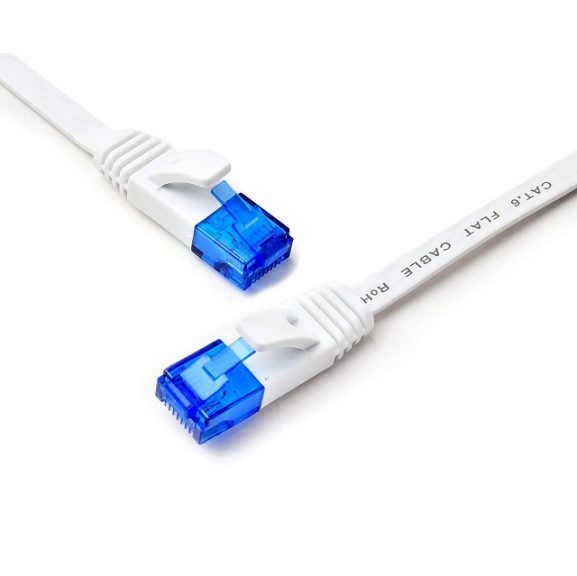Selecting any cable between cat6 vs Cat7 may be a tough decision for you. It is not suggested to use the category 7 cables for households as the wire doesn’t use RJ45. The line has a limited maximum length. Whether you’re looking for a cable for home or office uses, then Cat6a is best.
However, if you want to choose wires for future household usages, then both Category and Category7 Ethernet cables are the best. In this article, we will define the difference between Category and Category7 network wire. Besides, we also help you to know how to choose an Ethernet cable wire.
What is CAT6 Cable?
Most people prefer to use these standardized twisted pair wires. It is ideal to use for an Ethernet network. When you work on a system using category6 wire, you will get fewer errors. However, according to a few users, these cables are hard to install. The cables can be twisted to insulate it more than previous times.
The wire supports Category 3 and Category 5/5e cable standards. It has a lot more specifications like a reduced noise system compared to Category 5 and 5e. CAT6 was released in the market merely a few years later of category 5e. For the Category 6 cable, the network can support only 55 meters (180 ft) length for 10GBASE-T. These cables can support the Gigabit Ethernet segments up to 100 m. You can use 10-Gigabit networks in a limited distance.
Category6 can operate up to 250 MHz. It indicates that a category6 line can transfer enough data at a point of time. Sometimes, both cables will offer you the equal speed. But on a 4-lane highway, you can get more traffic compared to the 2-line highway. Category6 can be operated at 250 MHz frequency. It has four twisted pairs of copper wire. The size of the cables is 23 AWG gauge.
Category6 cables offer 250 MHz performance because of using a nylon spline in the wiring. This handy cable gives Near-End Crosstalk (NEXT) in the transmission. Besides, it assists in improving the ELFEXT, RL, and IL. Here, ELFEXT, RL, IL stand for Equal-Level Far-End Cross-talk, Return Loss, and Insertion Loss respectively.
Using cross-talk, you can get fewer system noise, higher data transmission rates, etc. The wires contain high isolated twisted pairs that make it a rigid line. In recent times, these cables are very flexible that help them to decrease noise while performing.
What is Cat7 Cable?
This type of wire can typically support 10 Gbps. This cable can transmit up to 40 GB at 50 meters and 100 GB at 15 meters. Here, you can get a new “Class F” cabling that can support up to 600 MHz frequencies. But it doesn’t get any approval as a wiring standard for telecommunications.
A Category7 Cable that we know as a Category 7e cable is used as the cabling infrastructure of Gigabit Ethernet. You can experience frequencies Up to 600MHz. It offers extensive shielding. Compared to previous generations of cabling, it is more stiff. In both cases, you can see an extra layer that covers the inner shielded parts. The category6 also has a few unique GigaGate45 (GG45) connectors. However, if you want the same higher performance features, you must choose such category wire that can support Vat 4t5.
You can get shielding from cross-talk and interference in both cases. You can use this wire in data centers and large enterprise networks. This cable has 600Mhz/10Gbps/100m and 40Gbps at 50m/100Gbps at 15m.
Cat6 vs Cat7
Specification
It is the main parameter that we need to elaborate while defining Cat6 vs Cat7. When it comes to crosstalk and system noise, Category 7 becomes unbeatable compared to others. It is compatible with traditional Category 5e and Category6 Ethernet. These cables contain Xmultiple’s UltraJAX connectors. These connectors have contact pads, and a printed circuit board, but no contact pins.
Transmission Frequency & Cabling Length
Whether you want to cover more than 100 distance, you have to amplify the signals with repeaters or switches. The maximum length that the category6 wire can support for 10/100/1000BASE-T is 328 ft. Here, you can see a robust “horizontal” cabling between the wall jack and the patch panel. And you can see a 16 ft long useful patch cable between each jack and the attached device. The highest wire length of the Category 6 is 109 meters.
For the case of Category 7 cable, the frequency the wire needs is up to 600 MHz. The wire is designed in such a way so that it can offer a Gigabit Ethernet over 100 m length.
Usages
We would suggest you to use the category6 cable for home usages. This cable offers you sufficient network speed by which you can easily download any games and save downloads in the library. Both Category6 wire and Category 6A cable can deliver an excellent network connection in a home. But if you want a cable for home uses, then you can choose Category7. It is perfect for running those devices that come with smart home technology. These cables are helpful for business purposes. The Category7 cable is compatible with many devices.
Installation
The category6 wires can transmit more bandwidth. And that’s why these wires are heavier compared to the Category7 cables. These cables are too costly to install. The cost of Category6 is about 50% more than category5 cables. Here, the conductors in the wire are twisted very tightly. There exists separators between the wires that are used to discard the cross-talk and boost insulation. It is the reason why we can’t connect these wires without modular connectors.
The installation cost of Category6 will be $1,500 whereas for Category 6A it is $2,250. And most surprisingly for Category7 the cost is $3,375. As the price of cables are increasing daily, the installation cost also gets increased.
Price
Whether you want to buy a Category6 cable of supported range 100 feet, it will cost more than $11. Category 6 is more expensive than the category 5e. Category 7 is more costly than category6. However, you can’t afford Category 6 and category 7, you can select the category Cat5e cable. It is an excellent option for those who want to use the 10G network.
What is the reason for twisting copper pairs?
While the telephone came out in the market, Alexander Graham Bell twisted the copper pairs of telephone. He, the inventor of the telephones, was the one who decreased the cross-talk between two lines. Here, the primary purpose is to decrease electromagnetic interference by twisting the copper wires. Ethernet wires use similar technology for reducing the cross-talk between external wires (AXT) and internal cables (XT).
More on Cat6 vs Cat7
Structure:
Category 6 wire divided into two different forms that are:- shielded and un-shielded. The Category7 wire has a shielded form. The shield of Category7 helps to handle the higher frequencies. The structure of the Category6 wires relies on the surrounding environment.
Speed difference
Both wires are beneficial in giving you an enough speed that helps you to power any device and applications. If you want a cable in your home or office, then both cables Category6 wire and Category7 wire can give you the ultimate benefits.
Category6 wires can support networks at shorter lengths (33 – 55m). The Category7 cable can support 10 GB network. But it is for a limited distance. These cables come with a range of 10 GB data transmission rate.
Performance at shorter distance
Proper connections, distance and environment are some dependable factors that you need to consider while using these cables. Whether you think that you need 10 GB network speed, then you can choose Category6 wire. But it is only when the distance is under 55 meters. The Category7 cable is best if you want to get 10 GB network speed for long distances. It can give you consistent performance for sure.
If you look at the recent network development trend, Category 7 wire gives more power and less voltage drop. It contains a broader copper cross-section. This cable contains an overall shield and a separate shielding in every pair.
Conclusion:
This article let you know about the difference between Cat6 vs Cat7. You can know here about the bandwidth, maximum length, uses, etc of each Ethernet cable.
Frequently Asked Questions:
- Are there any similarities between Category and Category 7 connectors?
Both Category and category 7 use similar types of connectors, and these rely on the installation. Most people use an RJ45 or keystone jack.
- Should I use Category 7 wires?
Although Category 7 cables are so expensive, these ones are also known as the most durable cables. Compared to category 5 and category6, these cables have longer lifespan. These wires are best for home uses.
- Can you use the Category 7 wire for the Internet?
These wires can support Category 5e and Category6 Ethernet. In this type of cable, you can find four twisted copper wire pairs. These cables designed in such a way so that it support Gigabit Ethernet over 100m length.
- Is Wi-Fi slower than Ethernet?
We use both WiFi connection and Ethernet to transmit data. Ethernet uses wires to transfer data. Whereas the WiFi connection sends data with wireless signals. But a WiFi connection can share data slower than the Ethernet connection. Although the Ethernet connection is very reliable and secure compared to the WiFi connection.
- Which wire is the best Ethernet cable?
Monoprice Cat5e Ethernet Cable is the best Ethernet cable. You can get this Cat 5e wire in a range of lengths— from 0.5ft to 100ft. The rate of this Ethernet cable is very low.







